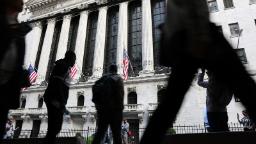Here’s what could tip the global economy into recession in 2023 | CNN Business


London
CNN
—
The global economy has endured a tough year, with decades-high inflation sapping post-lockdown spending and pushing central banks to hike borrowing costs at an unprecedented clip to bring it under control.
Their campaign to manage prices may be working — but potentially at a sizable cost in 2023.
“It is likely that the world economy will face recession next year as a result of the rises in interest rates in response to higher inflation,” Kay Daniel Neufeld, director and head of forecasting at the Center for Economics and Business Research, said this week.
Not everyone agrees the global economy is heading for a recession. Yet with growth expected to slip even lower after a sharp slowdown in 2022, it’s a possibility.
The International Monetary Fund projected in October that global growth will fall to 2.7% in 2023. Excluding the global financial crisis and the worst stage of the pandemic, that would be the weakest year for the world economy since 2001.
In November, the group warned the outlook had turned even “gloomier” since it published that forecast.
Whether a global recession materializes may come down to three factors: what central banks do next, the consequences of China’s nascent reopening and energy prices. Here’s how each of these variables could dictate the year ahead.
The IMF has called inflation “the most immediate threat to current and future prosperity.” And while it’s started to drop in the United States and Europe as energy prices pull back and higher interest rates feed through the economy, central banks have made clear they do not intend to stop hiking soon, even if they’re more comfortable with smaller increases.
“We’re not pivoting,” European Central Bank President Christine Lagarde said earlier this month. “We’re not wavering.”
Central bankers are operating on a meeting-by-meeting basis as they parse through the latest data. They have stressed they don’t know how high they’ll need to raise rates, or how long they’ll need to keep them there, in order to get inflation back near 2% and keep it there. If prices continue to rise by more than they’d like, central banks may be more aggressive than planned, putting further pressure on the global economy.
“We think that we’ll have to maintain a restrictive stance of policy for some time,” US Federal Reserve Chairman Jerome Powell said after the central bank’s December meeting.
For almost three years, the Chinese government has limited the spread of Covid-19 using centralized quarantines, mass testing and rigorous contact tracing. Now, following protests across the country against the stringent restrictions, it is abruptly rolling back these measures.
The imminent reopening of the world’s second-largest economy could spur growth. But it also carries risks.
“China’s current depressed state suggests that the potential for lift is large,” Bruce Kasman, head of economic and policy research at JPMorgan Chase, said earlier this month. “However, recent experience also shows that significant setbacks normally occur when openings are premature and healthcare systems are overwhelmed.”
A wave of coronavirus infections is currently sweeping China, but so far, Beijing is pushing ahead with plans to loosen its rules. This week, it announced it would drop quarantine requirements for international arrivals starting in early January in a major step toward reopening its borders. Other countries, meanwhile, are instating restrictions on travelers from China, fearing the development of new variants.
Russian President Vladimir Putin’s war in Ukraine continues to add uncertainty to forecasts, especially for countries in Europe, which are weaning themselves off Russian energy, but could still face shortfalls.
A report from the International Energy Agency found that Europe could face a natural gas shortage in 2023 if Russia cuts off all gas exports to the region and the weather turns colder.
Another wild card: The potential jump in demand for energy from China as its economy ramps back up.
“They’re interlinked,” said Diane Swonk, chief economist at KPMG. “One of the reasons energy prices are [lower] is because China is unusually weak.”
The Organization for Economic Cooperation and Development indicated its latest round of economic projections could require revisions if shortages of energy supplies push prices even higher, or if governments in Europe need to enforce rationing to lower demand for gas and electricity this winter and next.
Whether the world falls into recession or not, the next 12 months are likely to be difficult.
“It remains a challenging backdrop,” said Guillaume Menuet, Citi Private Bank’s head of investment strategy and economics in Europe, the Middle East and Africa.
His team predicts the world will experience the slowest economic growth in the last 40 years, aside from 2020 and the 2007-2008 financial crisis.
Even if a global recession is averted, many countries could still endure downturns accompanied by painful rises in unemployment, though economists don’t agree on how severe and long they might last.
“The worst is yet to come, and for many people 2023 will feel like a recession,” the IMF said in October, noting the slowdown “will be broad-based” and may “reopen economic wounds that were only partially healed post-pandemic.”






